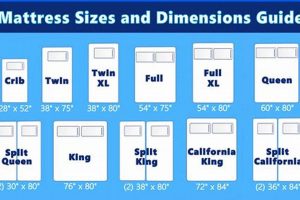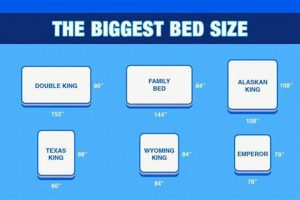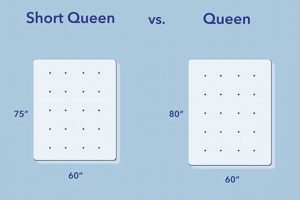The process of evaluating dimensions between different mattress types facilitates informed purchasing decisions. For instance, an individual might assess the spatial requirements of a twin mattress versus a queen mattress to determine the best fit for a bedroom. This analysis often involves considering factors such as room size, sleeping arrangements, and personal comfort preferences.
Understanding dimensional variances offers several advantages. It prevents the acquisition of a sleep surface disproportionate to the available space, maximizing room usability. Furthermore, a careful evaluation ensures adequate room for occupants, promoting restful sleep and overall well-being. Historically, dimensional choices were limited; however, modern manufacturing techniques have expanded the range of available options to accommodate diverse needs.
This article will delve into the specific measurements of standard mattress formats, addressing common considerations related to bedroom space planning, and explore the suitability of each type for various individuals and sleeping arrangements.
Selecting an appropriately sized mattress is crucial for optimizing sleep quality and bedroom space utilization. The following tips offer guidance for making informed decisions based on dimensional considerations.
Tip 1: Prioritize bedroom measurements. Before evaluating mattress options, accurately measure the available floor space to ensure sufficient room for the bed frame, walkways, and other furniture.
Tip 2: Account for sleeping partners. A larger mattress, such as a queen or king size, is generally recommended for couples to minimize sleep disturbances caused by movement.
Tip 3: Consider individual sleeping habits. Individuals who tend to move frequently during sleep may benefit from a larger sleep surface to prevent rolling off the mattress.
Tip 4: Evaluate the frame dimensions. Mattress sizes are standardized, but frame dimensions can vary slightly. Ensure compatibility between the chosen mattress and bed frame to avoid fit issues.
Tip 5: Factor in future needs. Anticipate potential changes in sleeping arrangements or living spaces. Selecting a mattress that accommodates potential future needs can be a cost-effective long-term strategy.
Tip 6: Analyze door and hallway widths. Verify that the selected mattress can be maneuvered through doorways and hallways to its intended location within the home.
Tip 7: Scrutinize warranty provisions. Determine whether the warranty requires specific bed frames or support systems that could impact overall mattress dimensions.
Careful assessment of mattress dimensions in relation to personal needs and spatial constraints can significantly enhance sleep comfort and overall bedroom functionality.
The subsequent sections will provide a detailed breakdown of specific mattress size specifications and their respective suitability for various applications.
1. Spatial footprint
The spatial footprint of a mattress, defined as the horizontal surface area it occupies, serves as a primary determinant in the “mattress size comparison” process. It directly influences room layout, movement within the space, and the overall suitability of a particular mattress dimension for a given environment.
- Room Dimensions
The most direct impact of a mattress’s spatial footprint is its relationship to the room’s dimensions. A larger mattress requires more floor space, potentially restricting movement and limiting the placement of other furniture. For instance, a California King mattress, while offering ample sleeping space, may overwhelm a small bedroom, creating a cramped and less functional environment. Conversely, a Twin mattress might feel disproportionately small in a large master suite, sacrificing potential comfort and aesthetic balance.
- Traffic Flow
Spatial footprint considerations extend beyond mere square footage. The mattress’s placement significantly affects traffic flow within the room. A mattress that obstructs doorways, walkways, or access to closets creates inconvenience and diminishes the overall usability of the space. “Mattress size comparison” must, therefore, integrate an analysis of the room’s layout to ensure unimpeded movement and accessibility.
- Furniture Arrangement
The spatial footprint of a mattress dictates the possibilities for furniture arrangement. A larger mattress may necessitate compromises in the size or number of other furniture pieces within the room. Nightstands, dressers, and seating areas may need to be scaled down or eliminated to accommodate the bed. Selecting an appropriately sized mattress allows for a more balanced and functional furniture arrangement that enhances the room’s overall aesthetic and utility.
- Perceived Space
Beyond its physical dimensions, a mattress’s spatial footprint influences the perceived size and openness of a room. A large mattress can visually dominate a small space, creating a sense of claustrophobia and reducing the perceived spaciousness. Conversely, a smaller mattress may appear underwhelming in a large room, leading to a sense of emptiness. Therefore, “mattress size comparison” must consider the psychological impact of the mattress’s size on the overall perception of the room.
The analysis of a mattress’s spatial footprint, in conjunction with “mattress size comparison,” allows for informed decision-making that balances comfort, functionality, and aesthetic considerations. By carefully assessing room dimensions, traffic flow, furniture arrangement, and perceived space, individuals can select a mattress that optimizes both sleep quality and the overall usability of their bedroom.
2. Sleeping capacity
Sleeping capacity, the number of individuals a mattress can comfortably accommodate, is intrinsically linked to mattress size comparison. Mattress dimensions directly dictate the viable sleeping capacity; a smaller surface inherently restricts the number of occupants who can rest without compromising sleep quality. The choice between a Twin, Full, Queen, King, or California King is fundamentally a decision about how many individuals the sleep surface needs to support. Selecting a mattress undersized for its intended occupancy leads to sleep disturbances, reduced individual space, and potential long-term discomfort. For example, a couple sharing a Twin mattress is likely to experience frequent awakenings due to limited space and partner movement, while a King-size mattress provides ample room for two adults to sleep undisturbed. The importance of sleeping capacity as a component of mattress size comparison cannot be overstated; it is a primary consideration for couples, families, or individuals who frequently host guests.
Further analysis reveals the practical implications of this connection. The sleeping habits and body sizes of occupants are crucial factors. Larger individuals require more personal space, potentially necessitating a larger mattress even if the number of occupants remains the same. For instance, two adults of above-average height may find a Queen mattress insufficient, opting instead for a King or California King. Conversely, two smaller individuals might find a Queen adequate. Lifestyle also plays a role; individuals who prefer to spread out while sleeping or share the bed with pets should consider a larger mattress. Another practical application arises in hospitality settings, where hotels and guest rooms must carefully consider mattress size relative to the expected occupancy to ensure guest satisfaction and avoid negative reviews stemming from inadequate sleeping space.
In summary, the connection between sleeping capacity and mattress size comparison is a foundational consideration in the mattress selection process. Failing to adequately assess sleeping capacity can lead to compromised sleep quality and discomfort. By understanding this relationship, individuals can make informed decisions that prioritize both comfort and spatial efficiency. The primary challenge lies in accurately anticipating future needs and accommodating potential changes in sleeping arrangements. Recognizing this linkage is vital for anyone seeking to optimize their sleep environment and invest in a mattress that effectively meets their individual or shared sleeping requirements.
3. Room compatibility
Room compatibility, as it pertains to “mattress size comparison,” represents a critical factor influencing the overall functionality and aesthetic coherence of a bedroom. The dimensions of a mattress must align proportionally with the room’s square footage to prevent spatial imbalance. A mattress that overwhelms a room creates a cramped environment, impeding movement and restricting furniture placement. Conversely, a mattress that is too small may appear visually disproportionate, leading to a sense of incompleteness. For instance, placing a California King mattress in a small apartment bedroom can severely limit walk-around space and diminish the room’s utility, while a Twin mattress in a large master suite might appear insignificant, creating an imbalance in the visual composition of the room. Consequently, accurate room measurements and careful dimensional assessment are essential prerequisites to effective “mattress size comparison.” The practical significance of understanding room compatibility lies in its direct impact on the room’s usability and aesthetic appeal.
Further analysis reveals the nuanced relationship between mattress size and room functionality. In smaller rooms, space-saving strategies, such as platform beds with integrated storage, can mitigate the impact of a larger mattress. Alternatively, strategically placed mirrors can create the illusion of increased space, compensating for a larger bed. In larger rooms, the placement of additional furniture, such as seating areas or dressers, can balance the visual weight of a smaller mattress. The location of windows and doors also influences mattress placement and size selection; obstructing natural light or access points compromises room functionality. Hotel rooms often exemplify the challenges of room compatibility; designers must balance guest comfort with spatial constraints, selecting mattress sizes that maximize sleep quality without overwhelming the available space. Practical application involves visualizing the room with the selected mattress in place, accounting for all existing and planned furniture, to ensure harmonious integration.
In summary, room compatibility is an indispensable consideration within the framework of “mattress size comparison.” It dictates the overall balance, functionality, and aesthetic appeal of a bedroom. The primary challenge resides in accurately assessing room dimensions and anticipating the impact of the mattress on the overall spatial dynamics. Overcoming this challenge requires careful planning, accurate measurements, and a clear understanding of the room’s intended purpose and design. Prioritizing room compatibility ensures that the chosen mattress enhances, rather than detracts from, the overall living environment.
4. Individual needs
Individual needs significantly dictate the optimal mattress size selection. Personal requirements, stemming from physical attributes, sleeping habits, and health conditions, directly influence the comfort and support derived from a given mattress dimension. A comprehensive “mattress size comparison” necessitates a thorough assessment of these individual factors to ensure adequate sleep quality and overall well-being.
- Body Size and Shape
Body size and shape are primary determinants in mattress size selection. Individuals with larger builds require greater surface area for comfortable sleep. Overhang, where portions of the body extend beyond the mattress edge, can lead to discomfort and disrupted sleep. Similarly, individuals with broader shoulders or hips may require a wider mattress to accommodate their physical dimensions without compression or restricted movement. Selecting a mattress based solely on standard dimensions without considering body size can result in inadequate support and reduced sleep quality.
- Sleeping Position
Preferred sleeping position influences the required mattress size. Side sleepers often benefit from a wider mattress to accommodate arm and leg extension without encroaching on a partner’s space. Back sleepers may require a longer mattress to prevent feet from hanging off the end, particularly for taller individuals. Stomach sleepers, while potentially requiring less width, may still benefit from a longer mattress to maintain spinal alignment. Neglecting to consider sleeping position during “mattress size comparison” can lead to postural discomfort and musculoskeletal issues.
- Health Conditions
Specific health conditions can necessitate particular mattress dimensions. Individuals with chronic pain, arthritis, or mobility limitations may require a higher profile mattress for easier ingress and egress. Those with respiratory issues, such as sleep apnea, may benefit from an adjustable base paired with a specific mattress size to facilitate positional adjustments for improved breathing. Individuals with allergies may require hypoallergenic mattresses of specific dimensions to minimize allergen exposure. Ignoring health conditions during “mattress size comparison” can exacerbate existing medical issues and impede sleep quality.
- Partner Considerations
When sharing a bed, partner needs must be factored into “mattress size comparison.” Differing body sizes, sleeping positions, and health conditions necessitate a compromise that accommodates both individuals. Motion isolation, the ability of a mattress to minimize the transfer of movement, becomes a crucial consideration. A larger mattress size often provides greater motion isolation, reducing sleep disturbances caused by partner movement. Addressing partner needs during mattress selection promotes harmonious sleep and prevents potential relationship strain resulting from incompatible sleep surfaces.
The integration of individual needs into the “mattress size comparison” process facilitates a more personalized and effective mattress selection. By considering body size, sleeping position, health conditions, and partner requirements, individuals can optimize their sleep environment and promote long-term comfort and well-being. This holistic approach ensures that the chosen mattress aligns with specific individual needs, maximizing the benefits of restorative sleep.
5. Budget considerations
Financial constraints invariably influence mattress purchasing decisions, necessitating a careful assessment of mattress dimensions in relation to cost. Budget considerations play a crucial role in determining the feasibility of various mattress sizes and associated expenses.
- Initial Purchase Price
Mattress dimensions directly correlate with purchase price. Larger mattresses, such as King and California King sizes, typically command higher price points than smaller Twin or Full sizes. This price differential reflects increased material costs and manufacturing complexities. Consumers must, therefore, align their mattress size preferences with their budgetary limitations, balancing comfort aspirations with financial realities. Discount retailers, sales events, and alternative brands may offer avenues for mitigating initial purchase expenses while still acquiring a suitable mattress size.
- Associated Costs
Beyond the initial purchase price, associated costs related to mattress size must be considered. Larger mattresses often necessitate larger bed frames, which contribute to the overall expense. Additionally, specialized bedding, such as sheets, comforters, and mattress protectors, are required to fit non-standard mattress dimensions, further increasing the financial burden. These ancillary costs should be factored into the budget analysis to provide a comprehensive understanding of the financial implications associated with a particular mattress size.
- Longevity and Replacement Costs
Mattress longevity and replacement costs indirectly relate to budget considerations within the context of “mattress size comparison.” While mattress size itself does not inherently dictate lifespan, the purchase of an undersized mattress, leading to discomfort and premature wear, can necessitate earlier replacement. Investing in an appropriately sized mattress, even if initially more expensive, can potentially yield long-term cost savings by extending the product’s lifespan and delaying replacement expenses. Consumers should, therefore, consider the long-term cost implications of mattress size choices.
- Financing Options and Payment Plans
For budget-conscious consumers, financing options and payment plans can facilitate the acquisition of a preferred mattress size. Many retailers offer installment payment options, allowing consumers to spread the cost of a more expensive mattress over an extended period. However, these financing options often involve interest charges, which should be carefully evaluated to determine the overall cost-effectiveness. Consumers must weigh the benefits of immediate access to a larger mattress against the potential financial burden of long-term financing obligations.
The interplay between mattress size and budget considerations necessitates a comprehensive financial assessment. Balancing comfort preferences, spatial requirements, and long-term cost implications allows consumers to make informed purchasing decisions that align with their budgetary constraints. Prioritizing value and longevity, while carefully evaluating financing options, can optimize the mattress investment and ensure long-term satisfaction.
6. Frame requirements
The dimensional compatibility between a mattress and its corresponding bed frame is fundamental for structural integrity, support, and overall sleep quality. Frame requirements are not arbitrary; they are inextricably linked to mattress size, influencing both the longevity of the sleep system and the safety of its occupants.
- Dimensional Conformance
Frame dimensions must precisely match mattress dimensions to provide adequate support and prevent shifting or sagging. A frame too small will leave the mattress unsupported, leading to premature wear and potential structural failure. Conversely, a frame too large will allow the mattress to move excessively, creating instability and discomfort. For instance, a Queen mattress placed on a Full-size frame will experience uneven weight distribution and reduced support, while a Twin mattress on a Queen-size frame will slide freely, creating a safety hazard. Exact dimensional conformance is, therefore, paramount for optimizing mattress performance and ensuring user safety.
- Support Structure
Bed frames provide the essential support structure necessary to distribute weight evenly across the mattress surface. The type of support system slats, solid platform, or box spring dictates the frame’s compatibility with specific mattress types. Memory foam mattresses, for example, often require solid or closely spaced slat support to prevent sagging, while innerspring mattresses may function adequately with a box spring. A mismatch between the mattress type and the frame’s support structure can compromise the mattress’s structural integrity and diminish its comfort. Therefore, careful consideration of the support system is crucial when assessing frame requirements.
- Weight Capacity
Bed frames are designed to support specific weight capacities, which must be commensurate with the combined weight of the mattress and its occupants. Exceeding the frame’s weight capacity can result in structural damage, instability, and potential collapse. Larger mattresses, particularly King and California King sizes, inherently weigh more and often require heavier-duty frames to accommodate the increased weight. Frame weight capacity should be explicitly specified by the manufacturer and carefully considered during the mattress size selection process to ensure safe and reliable performance.
- Headboard and Footboard Compatibility
Headboard and footboard attachments can impact frame requirements, particularly in terms of dimensional compatibility and structural support. Headboards and footboards designed for specific mattress sizes may not align properly with frames intended for other sizes, creating aesthetic inconsistencies and potential instability. Furthermore, the weight and design of headboards and footboards can influence the frame’s overall structural integrity. Careful consideration of headboard and footboard compatibility is essential for ensuring a cohesive and structurally sound bed system. Adapters might be required, introducing further complexity.
In conclusion, frame requirements are an inseparable aspect of “mattress size comparison.” Adhering to precise dimensional specifications, ensuring appropriate support structures, respecting weight capacities, and considering headboard/footboard compatibility are all essential for maximizing mattress performance, ensuring user safety, and optimizing the overall sleep experience. Ignoring these frame requirements can lead to premature mattress wear, structural instability, and potential physical harm. Careful adherence to manufacturer specifications and thorough assessment of compatibility factors are, therefore, crucial for responsible mattress selection.
7. Accessibility constraints
Accessibility constraints, encompassing physical limitations and spatial restrictions, significantly influence the “mattress size comparison” process. The ability to physically maneuver a mattress into its intended location and to comfortably access the bed thereafter represents a crucial, yet often overlooked, aspect of mattress selection. Factors such as doorway widths, stairwell dimensions, and personal mobility limitations must be considered to ensure practical feasibility and long-term usability.
- Doorway and Hallway Widths
Doorway and hallway widths present significant accessibility constraints. A mattress that cannot physically fit through these passageways renders it unusable, regardless of its suitability for sleeping comfort. Larger mattresses, such as King and California King sizes, pose particular challenges, often requiring careful maneuvering, temporary door removal, or even the use of specialized equipment for transport. Pre-purchase assessment of these dimensions is essential to avoid logistical complications and potential damage to the mattress or the dwelling.
- Stairwell Dimensions and Obstructions
Stairwells introduce additional complexities due to their inherent spatial limitations and potential obstructions. Tight turns, low ceilings, and narrow treads can impede the transport of bulky mattresses, particularly up or down flights of stairs. Sharp corners may necessitate tilting or bending the mattress, potentially causing damage or requiring multiple individuals for safe handling. Buildings lacking elevators present a significant accessibility constraint for upper-floor apartments or residences.
- Personal Mobility Limitations
Personal mobility limitations, stemming from age, disability, or physical injury, directly impact the accessibility of a mattress. Individuals with reduced mobility may find it difficult to climb onto or off of a high-profile mattress, necessitating careful consideration of mattress height. Furthermore, the weight and bulk of larger mattresses can make it challenging to make the bed or change the linens, imposing practical difficulties for individuals with limited strength or range of motion. Adjustable beds offer a potential solution, but require additional space and introduce further accessibility considerations related to control mechanisms.
- Elevator Dimensions and Weight Capacity
In multi-story buildings, elevator dimensions and weight capacity serve as critical accessibility constraints. Small elevators may not accommodate larger mattresses, forcing alternative transport methods. Furthermore, elevator weight restrictions may preclude the transport of heavier mattresses, particularly those constructed with dense materials. Prior confirmation of elevator specifications is essential to ensure feasible delivery and installation.
The interplay between these accessibility constraints and “mattress size comparison” underscores the importance of practical considerations beyond mere comfort and spatial fit. Overlooking these limitations can result in significant logistical challenges, potential property damage, and ongoing usability issues. Thorough assessment of accessibility factors is, therefore, a crucial component of informed mattress selection.
Frequently Asked Questions
The following questions address common inquiries regarding mattress dimensions, providing clarity on selecting the appropriate size for individual needs and spatial constraints.
Question 1: What is the standard dimensional difference between a Queen and a King mattress?
A standard Queen mattress measures approximately 60 inches in width and 80 inches in length. A standard King mattress measures approximately 76 inches in width and 80 inches in length. The primary difference lies in the width, with a King mattress offering 16 additional inches of lateral space.
Question 2: How does a California King mattress differ from a standard King mattress?
A California King mattress measures approximately 72 inches in width and 84 inches in length. Compared to a standard King, it is narrower by 4 inches but longer by 4 inches. This configuration is often preferred by taller individuals who require additional legroom.
Question 3: What factors should be considered when selecting a mattress size for two occupants?
For two occupants, factors such as individual body size, sleeping habits (e.g., movement during sleep), and personal space preferences should be considered. A Queen or King mattress is generally recommended to minimize sleep disturbances and provide adequate individual space. Motion isolation technology in the mattress construction is also a significant factor.
Question 4: How does mattress size impact bedroom design and furniture placement?
Mattress size directly influences bedroom design and furniture placement. A larger mattress requires more floor space, potentially limiting the placement of other furniture pieces. It is crucial to measure the room dimensions and account for walkways to ensure adequate space for both the bed and other essential furnishings.
Question 5: Are there specific mattress sizes recommended for individuals with back pain or other orthopedic concerns?
While mattress size alone does not directly address back pain, selecting an appropriately sized mattress that allows for comfortable spinal alignment is essential. Individuals with back pain should prioritize mattress support and firmness levels that accommodate their specific orthopedic needs, consulting with a healthcare professional if necessary.
Question 6: How do frame requirements vary across different mattress sizes?
Frame requirements are directly correlated with mattress size. The bed frame must provide adequate support and prevent shifting or sagging. Larger mattresses, such as King and California King sizes, require heavier-duty frames to accommodate the increased weight. Compatibility between the mattress type and the frame’s support structure (e.g., slats, solid platform) is also critical.
Accurate measurements, consideration of sleeping habits, and assessment of spatial constraints are critical when determining the appropriate mattress size. This information should clarify decision-making.
The subsequent section will provide guidance on optimizing sleep quality.
Mattress Size Comparison
This article has presented a comprehensive analysis of mattress size comparison, underscoring the multifaceted considerations that inform optimal selection. Key factors examined included spatial footprint, sleeping capacity, room compatibility, individual needs, budget constraints, frame requirements, and accessibility limitations. Successful navigation of these elements is critical for achieving a harmonious balance between sleep quality, spatial efficiency, and budgetary realities. Ignoring any of these interconnected aspects jeopardizes the investment, potentially leading to discomfort, spatial inefficiencies, or financial strain. Each dimension presents unique advantages and disadvantages, demanding careful evaluation relative to specific user requirements and environmental conditions.
Therefore, informed decision-making in mattress acquisition necessitates a diligent and methodical approach, prioritizing thorough assessment over impulsive purchase. The enduring impact of this decision on long-term well-being warrants a commitment to careful analysis and judicious resource allocation. Prioritizing diligent research before making a final selection remains the optimal strategy for ensuring lasting satisfaction and optimal sleep health.







